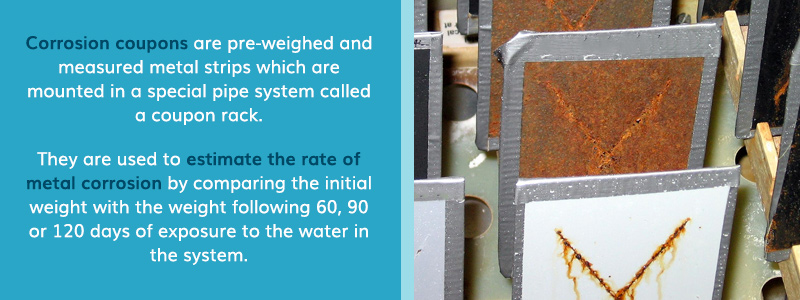Installing & Using Corrosion Coupons in Closed Loops
What Do Corrosion Coupons Do In Closed Loops?
Corrosion coupons are pre-weighed and measured metal strips which are mounted in a special pipe system called a coupon rack. They are used to estimate the rate of metal corrosion by comparing the initial weight with the weight following 60, 90 or 120 days of exposure to the water in the system. Corrosion coupons are available in a wide variety of materials to assess corrosion in all types of systems.

What Do Corrosion Coupons NOT Do In Closed Loops?
Corrosion coupons are installed in a system with the intention of predicting the corrosion rate for the entire system. The obvious flaw with this reasoning is that the flow and temperature through a corrosion coupon rack will never duplicate the corrosion forces elsewhere in most systems. There is little effect on the coupon by temperature which would typically be a severe corrosive effect in actuality.
The most reliable indication of corrosion in the concentration of the total iron in the recirculating water. Even so, many facilities require coupon studies and below is the detailed procedure for installing and monitoring coupons.
Is There Anything Special I Need To Know About Corrosion Coupons In Closed Loops?
Corrosion coupon analysis involves a number of variables which may significantly affect the results of the analysis. Make sure the design of the system and the installation of the coupon rack will produce accurate test results.
- Be careful not to touch the coupons. Oil from your hands will promote corrosion and bias the test results.
- Maintain constant flow at 3-5 feet per second during the test period. Flow rates below 3 fps will allow particulates to settle on the coupon and will bias the results. Flow rates in excess of 5 fps will erode soft metals such as copper and brass. In 3/4″ PVC pipe, 3-5 fps is equivalent to 5-8 gpm.
- Avoid corrosion coupon tests in comfort cooling systems during the spring and fall. Constant, consistent flow provides more realistic results. Inconsistent flow will cause higher corrosion results.
- Since the temperature of the water effects corrosion rate, installing the coupon rack after the heat source will result in higher corrosion rates. Conversely, installing the coupon rack after the tower will result in lower corrosion rates.
- The order of coupons in the rack is important. Less noble metals such as carbon steel should be mounted upstream of more noble metals such as copper. This prevents copper ions from plating onto the iron coupons and causing artificially high corrosion rates.
- Corrosion coupons installed in systems with oil or other hydrocarbon contamination will show artificially high corrosion rates due to sulfide attack. Corrosion coupon projects should be delayed until process leaks are under control or avoided altogether in contaminated systems.
- The direction of water flow is important. Water should flow from the unattached end of the coupon toward the attachment end of the coupon.
- Do not remove the coupons to look at them except at the end of the test period. Exposure to air, once the coupons are installed, can increase corrosion.
Before installing the coupons, complete the information on the coupon package. Turn off the system and carefully mount the coupons on the holder arms. Use a paper or cloth towel to prevent the oils on your skin from impacting the results. Once installed, turn the flow to the rack back on and adjust the flow rate to 3-5 fps. Maintain constant flow throughout the study. Store the coupon envelopes in the controller or in a dry place near the coupon rack.
Remove the coupons after 60, 90 or 120 days as specified by the study. Carefully remove and dry each coupon on a paper towel. Take care not to remove material deposited on the coupon because deposits are an important part of the evaluation. Place the coupon into the original envelope without the plastic bag. Record the date of removal and send the coupon back to the Chardon Technical Support Laboratory as soon as possible.
The results of the corrosion coupon analysis will be presented on a Laboratory Report for and include a written analysis, a photograph of the coupon, and a corrosion rate in mills per year, or mpy. Use the table below to evaluate the results from your study.
